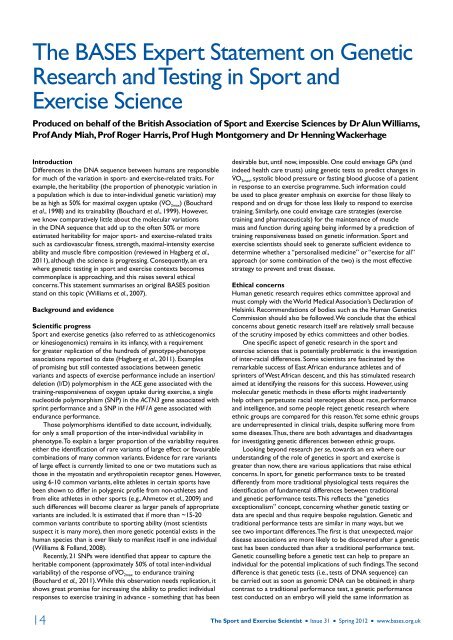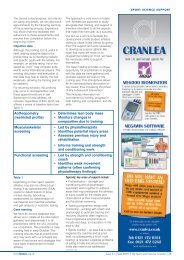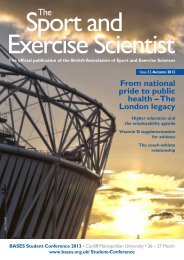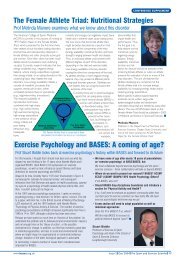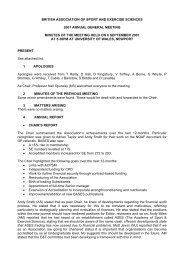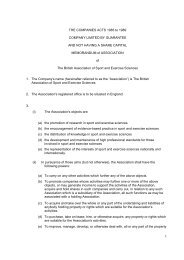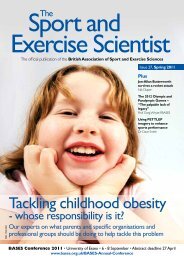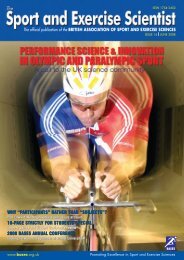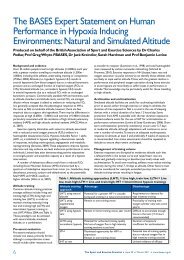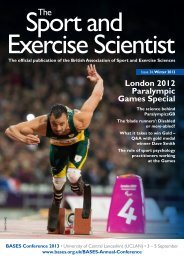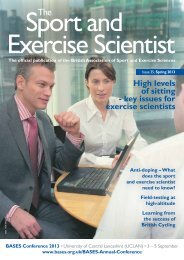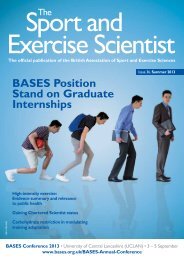Issue 31 Spring 2012 - Bases
Issue 31 Spring 2012 - Bases
Issue 31 Spring 2012 - Bases
You also want an ePaper? Increase the reach of your titles
YUMPU automatically turns print PDFs into web optimized ePapers that Google loves.
The BASES Expert Statement on Genetic<br />
Research and Testing in Sport and<br />
Exercise Science<br />
Produced on behalf of the British Association of Sport and Exercise Sciences by Dr Alun Williams,<br />
Prof Andy Miah, Prof Roger Harris, Prof Hugh Montgomery and Dr Henning Wackerhage<br />
Introduction<br />
Differences in the DNA sequence between humans are responsible<br />
for much of the variation in sport- and exercise-related traits. For<br />
example, the heritability (the proportion of phenotypic variation in<br />
a population which is due to inter-individual genetic variation) may<br />
be as high as 50% for maximal oxygen uptake (VO 2max ) (Bouchard<br />
et al., 1998) and its trainability (Bouchard et al., 1999). However,<br />
we know comparatively little about the molecular variations<br />
in the DNA sequence that add up to the often 50% or more<br />
estimated heritability for major sport- and exercise-related traits<br />
such as cardiovascular fitness, strength, maximal-intensity exercise<br />
ability and muscle fibre composition (reviewed in Hagberg et al.,<br />
2011), although the science is progressing. Consequently, an era<br />
where genetic testing in sport and exercise contexts becomes<br />
commonplace is approaching, and this raises several ethical<br />
concerns. This statement summarises an original BASES position<br />
stand on this topic (Williams et al., 2007).<br />
Background and evidence<br />
Scientific progress<br />
Sport and exercise genetics (also referred to as athleticogenomics<br />
or kinesiogenomics) remains in its infancy, with a requirement<br />
for greater replication of the hundreds of genotype-phenotype<br />
associations reported to date (Hagberg et al., 2011). Examples<br />
of promising but still contested associations between genetic<br />
variants and aspects of exercise performance include an insertion/<br />
deletion (I/D) polymorphism in the ACE gene associated with the<br />
training-responsiveness of oxygen uptake during exercise, a single<br />
nucleotide polymorphism (SNP) in the ACTN3 gene associated with<br />
sprint performance and a SNP in the HIF1A gene associated with<br />
endurance performance.<br />
Those polymorphisms identified to date account, individually,<br />
for only a small proportion of the inter-individual variability in<br />
phenotype. To explain a larger proportion of the variability requires<br />
either the identification of rare variants of large effect or favourable<br />
combinations of many common variants. Evidence for rare variants<br />
of large effect is currently limited to one or two mutations such as<br />
those in the myostatin and erythropoietin receptor genes. However,<br />
using 6-10 common variants, elite athletes in certain sports have<br />
been shown to differ in polygenic profile from non-athletes and<br />
from elite athletes in other sports (e.g., Ahmetov et al., 2009) and<br />
such differences will become clearer as larger panels of appropriate<br />
variants are included. It is estimated that if more than ~15-20<br />
common variants contribute to sporting ability (most scientists<br />
suspect it is many more), then more genetic potential exists in the<br />
human species than is ever likely to manifest itself in one individual<br />
(Williams & Folland, 2008).<br />
Recently, 21 SNPs were identified that appear to capture the<br />
heritable component (approximately 50% of total inter-individual<br />
variability) of the response of VO 2max to endurance training<br />
(Bouchard et al., 2011). While this observation needs replication, it<br />
shows great promise for increasing the ability to predict individual<br />
responses to exercise training in advance - something that has been<br />
desirable but, until now, impossible. One could envisage GPs (and<br />
indeed health care trusts) using genetic tests to predict changes in<br />
VO 2max , systolic blood pressure or fasting blood glucose of a patient<br />
in response to an exercise programme. Such information could<br />
be used to place greater emphasis on exercise for those likely to<br />
respond and on drugs for those less likely to respond to exercise<br />
training. Similarly, one could envisage care strategies (exercise<br />
training and pharmaceuticals) for the maintenance of muscle<br />
mass and function during ageing being informed by a prediction of<br />
training responsiveness based on genetic information. Sport and<br />
exercise scientists should seek to generate sufficient evidence to<br />
determine whether a “personalised medicine” or “exercise for all”<br />
approach (or some combination of the two) is the most effective<br />
strategy to prevent and treat disease.<br />
Ethical concerns<br />
Human genetic research requires ethics committee approval and<br />
must comply with the World Medical Association’s Declaration of<br />
Helsinki. Recommendations of bodies such as the Human Genetics<br />
Commission should also be followed. We conclude that the ethical<br />
concerns about genetic research itself are relatively small because<br />
of the scrutiny imposed by ethics committees and other bodies.<br />
One specific aspect of genetic research in the sport and<br />
exercise sciences that is potentially problematic is the investigation<br />
of inter-racial differences. Some scientists are fascinated by the<br />
remarkable success of East African endurance athletes and of<br />
sprinters of West African descent, and this has stimulated research<br />
aimed at identifying the reasons for this success. However, using<br />
molecular genetic methods in these efforts might inadvertently<br />
help others perpetuate racial stereotypes about race, performance<br />
and intelligence, and some people reject genetic research where<br />
ethnic groups are compared for this reason. Yet some ethnic groups<br />
are underrepresented in clinical trials, despite suffering more from<br />
some diseases. Thus, there are both advantages and disadvantages<br />
for investigating genetic differences between ethnic groups.<br />
Looking beyond research per se, towards an era where our<br />
understanding of the role of genetics in sport and exercise is<br />
greater than now, there are various applications that raise ethical<br />
concerns. In sport, for genetic performance tests to be treated<br />
differently from more traditional physiological tests requires the<br />
identification of fundamental differences between traditional<br />
and genetic performance tests. This reflects the “genetics<br />
exceptionalism” concept, concerning whether genetic testing or<br />
data are special and thus require bespoke regulation. Genetic and<br />
traditional performance tests are similar in many ways, but we<br />
see two important differences. The first is that unexpected, major<br />
disease associations are more likely to be discovered after a genetic<br />
test has been conducted than after a traditional performance test.<br />
Genetic counselling before a genetic test can help to prepare an<br />
individual for the potential implications of such findings. The second<br />
difference is that genetic tests (i.e., tests of DNA sequence) can<br />
be carried out as soon as genomic DNA can be obtained; in sharp<br />
contrast to a traditional performance test, a genetic performance<br />
test conducted on an embryo will yield the same information as<br />
14 The Sport and Exercise Scientist n <strong>Issue</strong> <strong>31</strong> n <strong>Spring</strong> <strong>2012</strong> n www.bases.org.uk


